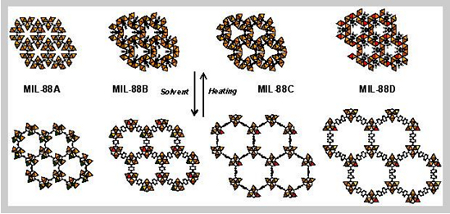Entropy of the solid state: study of porous materials with phonon and molecular dynamics calculations
Entropy of the solid state: study of porous materials with phonon and molecular dynamics calculations
Promotor(en): V. Van Speybroeck, A. Ghysels /MM_14_MODEV_06 / Model and software developmentNanoporous zeolite crystals are widely used for the adsorption and separation of small molecules, such as CO2 and volatile organic compounds. Scientists are still searching for the optimal zeolite in terms of adsorption and selectivity. A completely experimental approach, in which all posible zeolites are synthesized and characterized, is impossible due to the immense number of possible zeolites. Therefore, a computation screening approach is much more efficient. Molecular modeling of these materials could provide an accurate alternative to estimate the adsorption capacities and selectivities of candidate nanoporous materials before they are made. However, some zeolites are known to possess a certain degree of flexibility, and the effect of this framework flexibility on the adsorption properties is still not well understood. Especially the calculation of the framework entropy proves to be difficult. Moreover, the link between flexibility and entropy is to date still unclear. Not all hypothetical zeolite structures may be synthesized, because most experience some internal stresses: the building blocks hinder each other. Entropy has been suggested for being responsible for the restrictions in which materials can and which can not be synthesized. The long term aim is therefore to shed a light on the role of entropy. Therefore, new methodological developments are needed to improve the accuracy of entropy calculations using molecular simulations, which is the goal of this thesis.

Methodology: Entropy of porous solids Physics says that a molecular system minimizes its energy at zero Kelvin, while at a finite temperature the system minimizes its free energy. The key quantity here is the entropy: how many states are available to the system given an amount of thermal energy? A direct evaluation of the entropy by counting every state is in practice intractable for high-dimensional (dimension>6) systems. The entropy should then be calculated in an approximate manner, by using a smart sampling of phase space. Several methods are already available in literature to calculate entropy from molecular simulations. A first method uses the concept of phonons to calculate the dispersion relation, construct the density of states, and derive the partition function. This approach assumes that the potential energy surface is locally harmonic, which might be a poor assumption for the porous zeolite materials. The phonon method has been implemented and is available at the Center for Molecular Modeling. A second method, known as Molecular Dynamics (MD), integrates Newton's equations to construct molecular trajectories. MD has the advantage that anharmonicity is automatically taken into account. Extracting the entropy from MD is still challenging: the sampling should be ergodic and sufficiently long, and entropy is only available from a series of MD trajectories. Nevertheless, recently an approximate entropy-extraction method was developed for entropy calculation from a single MD trajectory, which however should still be implemented.
The porosity (empty space) of zeolites and other nanoporous materials poses a non-trivial challenge for these methods. These porous flexible crystals differ from conventional solid state, because they have pores and channels of diameter 0.5 to 2 nm. Their entropoy is therefore expected to differ from the entropy of common dense crystals. While phonons travel unhindered in perfect crystals, the pores are expected to localize phonons, with unknown repercussions on the entropy. The central goal of the thesis is to investigate the effect of pores on the free energy.
Goal A first step is the derivation, implementation and testing of the three proposed methods (phonon, series of MD, approximation from single MD) on a toy system, e.g. consisting of one type of idealized atoms. By gradually creating a pore of increasing size, the student may investigate the effect of material density on the free energy. Open questions are, for instance: How important are the anharmonicities? Is there a specific temperature range where the approximate model works? What are the a priori conditions for the phonon spectrum to be accurate enough? A second step is the application on common zeolite materials, selected to represent materials with various densities. Being able to trace the free energy as function of the density, could give valuable information about the thermal stability. Also, the newly developed methods will be used to investigate the connection between entropy and strain restrictions in hypothetical materials to guide the experimental community towards synthesis of new nanoporous materials.
- Study programmeMaster of Science in Engineering Physics [EMPHYS], Master of Science in Physics and Astronomy [CMFYST]

